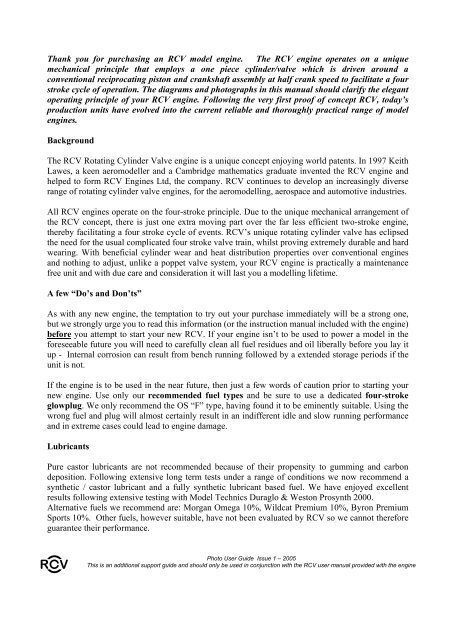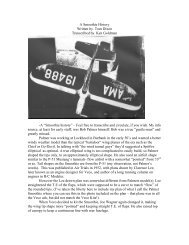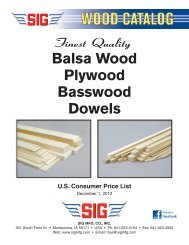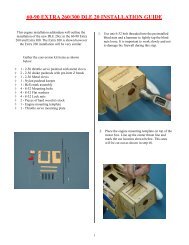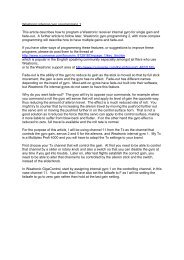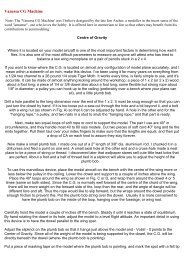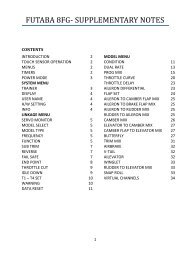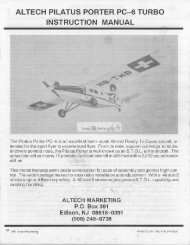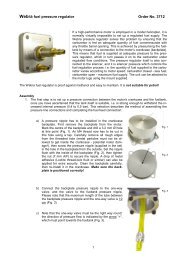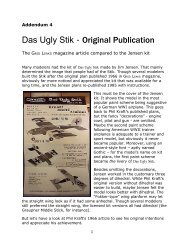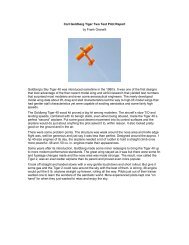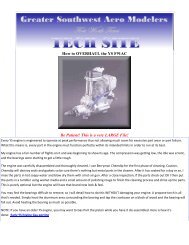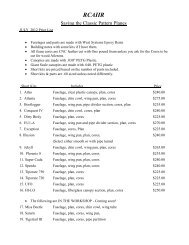Thank you for purchasing an RCV model engine. The RCV engine ...
Thank you for purchasing an RCV model engine. The RCV engine ...
Thank you for purchasing an RCV model engine. The RCV engine ...
Create successful ePaper yourself
Turn your PDF publications into a flip-book with our unique Google optimized e-Paper software.
Nitrometh<strong>an</strong>e (Nitro)Fuel containing less th<strong>an</strong> 10% nitro will produce indifferent idling <strong>an</strong>d throttling per<strong>for</strong>m<strong>an</strong>ce eventhough peak power will not unduly suffer. Nitro, although generally regarded as a power enh<strong>an</strong>cingadditive is primarily used to improve flexibility <strong>an</strong>d throttle response. Be wary of fuel m<strong>an</strong>ufacturerswho quote liquor qu<strong>an</strong>tities by weight rather th<strong>an</strong> volume. Nitro is a great deal heavier th<strong>an</strong> meth<strong>an</strong>ol(or oil) <strong>an</strong>d as a rough guide fuels quoting contents by weight will need a 15% Nitro mix! Usingappreciably more th<strong>an</strong> 10% Nitro (by volume) is not recommended as the increased cylinderpressures invoked may overstress <strong>you</strong>r <strong>engine</strong>.Receiving <strong>you</strong>r <strong>engine</strong>Your new <strong>RCV</strong> will arrive in a sturdy box, insidewhich will be a padded wrap containing the <strong>engine</strong>in its own polythene oily protective bag. Each<strong>engine</strong> is individually tested at our UK factory priorto dispatch.<strong>The</strong> muffler assembly is separately bagged,together with a pair of Allen keys <strong>for</strong> adjustment<strong>an</strong>d servicing needs. <strong>The</strong> warr<strong>an</strong>ty <strong>an</strong>d instructionsheets are also included. Be sure to read thesethoroughly <strong>an</strong>d register <strong>you</strong>r warr<strong>an</strong>ty immediately.Receiving <strong>you</strong>r <strong>engine</strong>CD <strong>engine</strong>s arrive with their carburetors affixed tothe m<strong>an</strong>ifold which will then require <strong>you</strong> to boltthis assembly to the <strong>engine</strong> casing. Use moderatepressure, employing the supplied Allen keys toaffix this component. Do not be tempted toovertighten, <strong>an</strong>d Do not <strong>for</strong>get the gasketCD Series CarburettordPhoto User Guide Issue 1 – 2005This is <strong>an</strong> additional support guide <strong>an</strong>d should only be used in conjunction with the <strong>RCV</strong> user m<strong>an</strong>ual provided with the <strong>engine</strong>
<strong>The</strong>re is a plastic plug sealing the inlet nipple <strong>an</strong>dthis, together with the breather nipple on thecr<strong>an</strong>kcase on the CD <strong>model</strong>s, will need removingbe<strong>for</strong>e use. <strong>The</strong>se covers are a protective measureonly <strong>for</strong> storage purposesRemove the black plug- this is <strong>for</strong> storage onlyInitial starting <strong>an</strong>d running inStarting <strong>you</strong>r new <strong>RCV</strong> <strong>for</strong> the first time should be <strong>an</strong> enjoyable <strong>an</strong>d trouble free experienceproviding <strong>you</strong> adopt a methodical <strong>an</strong>d workm<strong>an</strong>like approach.<strong>The</strong> <strong>engine</strong> should be firmly mounted in a safe environment. <strong>The</strong> SP <strong>model</strong>s drive huge propellers<strong>an</strong>d must be mounted accordingly due to the torque reaction from <strong>an</strong> 18 –20 inch coarse pitchedpropeller, which is considerable. Do not run <strong>you</strong>r <strong>engine</strong> in <strong>an</strong> enclosed space such as a <strong>you</strong>rworkshop or the garden shed due to the very real risk of carbon monoxide poisoning. Do ensure thatall clothing is secure <strong>an</strong>d that rags <strong>an</strong>d the like are not casually left on the bench.Anything that c<strong>an</strong> get caught in the propeller will in all likelihood be ingested with potentiallyd<strong>an</strong>gerous results. Ensure that there is plenty of room to walk around <strong>you</strong>r <strong>engine</strong> whilst running it sothat <strong>you</strong> remain out of harms reach at all times. Never st<strong>an</strong>d in front or to the side of the propellerwhilst <strong>an</strong> <strong>engine</strong> is running. In the eventuality of a thrown propeller or part thereof, <strong>you</strong>r only placeof safety is behind the propeller arc. Tachometer measurements should always be taken from the rear<strong>an</strong>d we advocate that <strong>you</strong> stop the <strong>engine</strong> to make fine carburetor adjustments <strong>for</strong> <strong>you</strong>r own safety.Propeller selectionWhilst <strong>you</strong>r eventual propeller selection will depend on the <strong>model</strong> that the <strong>engine</strong> is used in, <strong>for</strong>initial running in purposes <strong>an</strong>d general h<strong>an</strong>dling familiarity we recommend the following propellers.<strong>RCV</strong> 58 CD – 12 x 6<strong>RCV</strong> 91 CD – 14 x 6<strong>RCV</strong> 60 SP – 16 x 12<strong>RCV</strong> 90 SP – 18 x 12<strong>RCV</strong> 120 SP – 18 x 12 or 20 x 12We have extensively tested a wide variety <strong>an</strong>d r<strong>an</strong>ge of propeller types <strong>an</strong>d sizes <strong>an</strong>d the sizesindicated above represent a good general choice <strong>for</strong> <strong>engine</strong> familiarisation <strong>an</strong>d general flying. Inpractice we have also enjoyed good results with APC’s 12.25 x 3.75 (dedicated fun fly) propeller onthe 58CD in lightweight aerobatic <strong>model</strong>s. APC’s 13 x 6 / 14 x 6 / 15 x 4 per<strong>for</strong>m well on the 91 CDwith the smaller diameters more suited to faster flying WWII fighter types <strong>an</strong>d the like.dPhoto User Guide Issue 1 – 2005This is <strong>an</strong> additional support guide <strong>an</strong>d should only be used in conjunction with the <strong>RCV</strong> user m<strong>an</strong>ual provided with the <strong>engine</strong>
<strong>The</strong> SP <strong>model</strong>s will disappoint if propellers with less th<strong>an</strong> 10 inch are employed due to their gearedoutputs which halve the output RPM (whilst doubling the torque) over conventional <strong>model</strong> aero<strong>engine</strong>s (ie half the RPM = twice the torque = twice the pitch required)We recommend APC propellers (& other glass composite props) finding these to be both efficient<strong>an</strong>d quiet. <strong>RCV</strong> carry stocks of these in suitable sizes should <strong>you</strong> have difficulty obtaining the correctpropeller from <strong>you</strong> local dealer. As <strong>an</strong> approximate guide, <strong>you</strong>r SP should be fitted with propellersthat rotate between 5000 <strong>an</strong>d 6000 RPM whilst the 58 CD <strong>an</strong>d the 91 CD run most efficientlybetween 9000 <strong>an</strong>d 13000 RPM. Propellers should be employed that load the <strong>engine</strong>s to these speeds.Three <strong>an</strong>d four bladed propellers will need to bereduced in size by approximately one inch ineither pitch or diameter per blade increase. One ofthe great benefits of the SP series <strong>engine</strong>s is thatthey pull large scale like 3 & 4-bladed props.We have extensively tested the SP r<strong>an</strong>ge on three<strong>an</strong>d four bladed propellers <strong>an</strong>d c<strong>an</strong> supply suitablesizes or offer suggested fitments.16x10 3-bladed prop on <strong>RCV</strong>60SPWooden Props – <strong>RCV</strong> don’t recommend the use of wooden propellers as quality <strong>an</strong>d weight c<strong>an</strong>differ signific<strong>an</strong>tly. In generally wooden props are much lighter th<strong>an</strong> glass composite propellers <strong>an</strong>dso do not give the desired flywheel effect. This c<strong>an</strong> result in increased vibration on the SP series<strong>engine</strong>s. Saying this however, m<strong>an</strong>y of our customers have used wooden propellers successfully.Zinger Propellers seem to work well with our <strong>engine</strong>s.Starting a the new <strong>engine</strong>New <strong>engine</strong>s will be very tight <strong>an</strong>d may on occasion prove reluct<strong>an</strong>t to turn sufficiently briskly withsome less powerful starters. New 15 <strong>an</strong>d 20cc units will need a fairly powerful starter initiallyalthough once broken in, frictional resist<strong>an</strong>ce will be greatly reduced which makes starterper<strong>for</strong>m<strong>an</strong>ce less dem<strong>an</strong>ding. Ensure that <strong>you</strong>r starter leads are sufficiently robust <strong>an</strong>d that <strong>you</strong>rbattery is capable of delivering the amperage needed to turn the <strong>engine</strong> at a reasonable speed <strong>for</strong>starting. Corroded or very small battery connectors allied to long lightweight leads will almostcertainly cause <strong>you</strong>r <strong>engine</strong> to rotate too slowly to start.<strong>The</strong> SP series requires <strong>you</strong>r starter to rotateclockwise, me<strong>an</strong>ing that the leads will be reversedfrom convention due to their geared output shaftswhich reverses the direction of the drive. Finally,some power p<strong>an</strong>els are rather less th<strong>an</strong> capable ofsupplying sufficient current to maintain a goodglow whilst driving a powerful startersimult<strong>an</strong>eously <strong>an</strong>d <strong>for</strong> that reason we advocate aseparate glow battery.Starting the SP <strong>engine</strong> from behind the propdPhoto User Guide Issue 1 – 2005This is <strong>an</strong> additional support guide <strong>an</strong>d should only be used in conjunction with the <strong>RCV</strong> user m<strong>an</strong>ual provided with the <strong>engine</strong>
Behind the propeller starting is potentially thesafest method <strong>for</strong> <strong>an</strong>y <strong>model</strong> <strong>engine</strong> operation <strong>an</strong>dwith the SP r<strong>an</strong>ge this is strongly advised.Study the photographs paying particular attentionto the reversal of the battery leads on <strong>you</strong>r starter.This is necessary due to the gearing which reversesthe propeller direction on these <strong>model</strong>s.If starting from behind the propeller,remember to reverse the leads!!Running InRunning in <strong>you</strong>r new <strong>RCV</strong> is simple if a few basic rules are followed. <strong>The</strong>se are not <strong>RCV</strong> rules perse; but rather rules <strong>for</strong> running in <strong>an</strong>y <strong>engine</strong>.1 Ensure that <strong>you</strong>r <strong>engine</strong> is securely mounted, having previously gone over every fixing onthe unit <strong>an</strong>d in particular the carburetor screws & muffler, ensuring that these are tight. Donot overtighten <strong>an</strong>ything, but do ensure that nothing is about to drop off or loosen. Like<strong>an</strong>y other production <strong>engine</strong>ered product, hum<strong>an</strong> error may well throw up the odd fixingthat hasn’t been fully tightened <strong>an</strong>d checking be<strong>for</strong>e running is there<strong>for</strong>e a sensibleprecaution.2 On the CD series do not open up the <strong>engine</strong> mounting holes. This c<strong>an</strong> weaken the <strong>engine</strong>cr<strong>an</strong>kcase so is not recommended.3 We strongly advocate familiarisation in a test st<strong>an</strong>d environment, but should <strong>you</strong> decide tofit <strong>you</strong>r <strong>engine</strong> directly into the <strong>model</strong>, this will suffice <strong>for</strong> the purpose of running in theCD series, providing that <strong>you</strong> run a few t<strong>an</strong>ks of fuel through on the ground first. Break intimes vary with most <strong>engine</strong>s needing one to three hours of accumulated time be<strong>for</strong>egiving their best. <strong>The</strong> SP <strong>model</strong>s tend to need more time th<strong>an</strong> the CD <strong>model</strong>s, particularlythe 120 which has a lot of large components to bed in. During the run-in period vibrationmay be higher so it is best carried out on a test st<strong>an</strong>d.4 All <strong>RCV</strong> <strong>engine</strong>s are run prior to dispatch, there<strong>for</strong>e carb settings will be pretty much set.Running <strong>you</strong>r new <strong>engine</strong> <strong>for</strong> the first time should be executed in relatively short bursts –say 3 to 5 minutes with a measurable period of cooling between runs. Set the needle rich<strong>an</strong>d run the <strong>engine</strong> initially on about half throttle which will allow things to bed in nicely.After half <strong>an</strong> hour of accumulated time run the <strong>engine</strong> <strong>for</strong> short full power bursts, but stillon a slightly rich setting, gradually increasing the workload of the unit until it feels“snappy” <strong>an</strong>d it will hold peak RPM without sagging. At this juncture <strong>you</strong> c<strong>an</strong> attend tothe low speed mixture setting. If adjustment is needed it should only require a ¼ turneither way. <strong>The</strong>re is little point in trying to adjust this initially with a tight <strong>engine</strong>.dPhoto User Guide Issue 1 – 2005This is <strong>an</strong> additional support guide <strong>an</strong>d should only be used in conjunction with the <strong>RCV</strong> user m<strong>an</strong>ual provided with the <strong>engine</strong>
Adjusting the main needleAdjusting the idle needleSettingsYour carburetor will in all likelihood be set very rich on the slow running or secondary needle assupplied from the factory as previously mentioned. This is intentional as it ensures that the <strong>engine</strong>will start, given that four strokes need to be relatively rich when compared with a two strokecounterpart. We suggest that <strong>you</strong> pay little heed to the secondary setting <strong>for</strong> the first 15 minutes ofrunning as the newness of the <strong>engine</strong> will preclude accurate settings <strong>an</strong>d it is far better to err on therich side to begin with.<strong>The</strong> main needle valve setting will need to besomewhere between three quarters <strong>an</strong>d one <strong>an</strong>d a halfturns open from fully closed but t<strong>an</strong>k position <strong>an</strong>dplumbing issues will affect this to a degree. <strong>The</strong>throttle must be fully open when this adjustment ischecked. With the throttle barrel in the closed positionthe main needle will bottom out against the spraybar.All four stroke <strong>model</strong> glow <strong>engine</strong>s need to be wet <strong>for</strong>cold starts. To affect a choke mech<strong>an</strong>ism, simply placea finger over the inlet venturi with the throttle wideopen. Turn the “choked” <strong>engine</strong> over a few times byh<strong>an</strong>d until fuel is drawn into the carburetor. Close thethrottle to about one third <strong>an</strong>d turn the <strong>engine</strong> over acouple of times to check <strong>for</strong> flooding or hydrauliclocking be<strong>for</strong>e energising the glowplug <strong>an</strong>d starter.With sufficient richness <strong>an</strong>d a good glow the resultwill be <strong>an</strong> immediate start.Spraybar enddPhoto User Guide Issue 1 – 2005This is <strong>an</strong> additional support guide <strong>an</strong>d should only be used in conjunction with the <strong>RCV</strong> user m<strong>an</strong>ual provided with the <strong>engine</strong>
Placing a finger over the exhaust outlet whilst spinning the <strong>engine</strong> on the starter will also choke the<strong>engine</strong> effectively if exhaust pressure feeds the t<strong>an</strong>k system but be aware that this c<strong>an</strong> lead to severeflooding if overdone.Silencers<strong>RCV</strong> four stroke <strong>engine</strong>s are not unduly noisy but allare supplied with a small (typical) silencer. Silencersc<strong>an</strong> vibrate loose <strong>an</strong>d if <strong>you</strong>r <strong>engine</strong> mounts are lessth<strong>an</strong> good, silencer damage c<strong>an</strong> result fromcontinued running with the result<strong>an</strong>t severevibration. Almost all silencer woes c<strong>an</strong> be attributedto poor <strong>engine</strong> mounts or insufficiently tightenedexhaust systems to begin with. Exhaust systemsshould be rechecked <strong>an</strong>d tightened with the <strong>engine</strong> atrunning temperature to reduce the ch<strong>an</strong>ces of furtherloosening due to heat exp<strong>an</strong>sion. Periodic checkingis of course a wise precaution.Exhaust Locking nuts should be retightenedwhen hotThrottle linkagesThrottle linkages should enjoy a direct straight runwherever feasible. Reliable throttle operation c<strong>an</strong>only take place if the linkage is geometrically correct<strong>an</strong>d slop or bind free. On typical ARTF installations,the supplied (usually) wire <strong>for</strong> the throttle linkageshould be insulated with heat shrink tubing here toreduce the ch<strong>an</strong>ces of radio interference (slight) frommetal to metal contact.Insulation heredPhoto User Guide Issue 1 – 2005This is <strong>an</strong> additional support guide <strong>an</strong>d should only be used in conjunction with the <strong>RCV</strong> user m<strong>an</strong>ual provided with the <strong>engine</strong>
On Board Glow SystemsOn board glow systems are worthwhile <strong>for</strong> multi <strong>engine</strong> scale <strong>model</strong>s where the ultimate in reliabilityis paramount. We have enjoyed successful results with the Telco glow driver which operates“intelligently” by supplying current to the plug on dem<strong>an</strong>d only.Telco on board glow system – Sub C cell will facilitate both starting <strong>an</strong>d flying whilst asingle AA cell is sufficient <strong>for</strong> flying onlyTrouble shootingIf <strong>you</strong>r <strong>engine</strong> refuses to fire then check <strong>you</strong>r plug <strong>an</strong>d particularly <strong>you</strong>r glow battery - the plugelement should be <strong>an</strong> or<strong>an</strong>ge colour when energised – rather th<strong>an</strong> a dull red. Check the rotationaldirection of <strong>you</strong>r starter. We have had m<strong>an</strong>y SP owners try to start their <strong>engine</strong>s backwards with thestarter rotating <strong>an</strong>ti clockwise (ie the conventional direction) <strong>an</strong>d it’s a common mistake! With ahealthy bright or<strong>an</strong>ge glow allied to sufficient richness <strong>an</strong>d with the throttle set to one third <strong>you</strong>r<strong>RCV</strong> will start very quickly. All <strong>RCV</strong> <strong>engine</strong>s are easy <strong>an</strong>d quick starters <strong>an</strong>d a logical <strong>an</strong>dmethodical approach will soon determine <strong>an</strong>y reason <strong>for</strong> failure.Warr<strong>an</strong>ty claimsProviding <strong>you</strong>r <strong>RCV</strong> <strong>engine</strong> is operated in accord<strong>an</strong>ce with these instructions it is guar<strong>an</strong>teed againstall m<strong>an</strong>ufacturing defects <strong>for</strong> a period of 2 years. <strong>RCV</strong> <strong>engine</strong>s Ltd are UK based <strong>an</strong>d we areavailable to <strong>an</strong>swer technical or warr<strong>an</strong>ty enquiries by email or telephone. If <strong>you</strong>r <strong>engine</strong> needs to bereturned <strong>for</strong> <strong>an</strong>y reason, please use the original packaging <strong>an</strong>d documentation.ApplicationsCustomers have fitted the entire r<strong>an</strong>ge of <strong>RCV</strong><strong>engine</strong>s to a very diverse selection of <strong>model</strong>types worldwide. Some of the more exotic orunusual <strong>model</strong>s have been made known to us<strong>an</strong>d our technical team, all keen aero<strong>model</strong>lers,will be more th<strong>an</strong> happy to offer advice <strong>an</strong>din<strong>for</strong>mation should <strong>you</strong> have <strong>an</strong> unusualproject in mind. Some extremely sophisticatedcompetition winning scale <strong>model</strong>s havebenefited from the unique characteristics oftheir <strong>RCV</strong> <strong>engine</strong>(s).dSplendid scratch build Flying Flea powered by<strong>RCV</strong>58CDPhoto User Guide Issue 1 – 2005This is <strong>an</strong> additional support guide <strong>an</strong>d should only be used in conjunction with the <strong>RCV</strong> user m<strong>an</strong>ual provided with the <strong>engine</strong>
H<strong>an</strong>gar 9 ARTF Must<strong>an</strong>g – <strong>RCV</strong> 91CD powered– note how the compact nature of the CDfacilitates a fully cowled <strong>engine</strong>FAQHow powerful is my <strong>RCV</strong> <strong>engine</strong>?Whilst our <strong>engine</strong>s are not as powerful as out <strong>an</strong>dout competition types, having been <strong>engine</strong>ered <strong>for</strong>reliability <strong>an</strong>d longevity, they all per<strong>for</strong>mwillingly <strong>an</strong>d enjoy excellent h<strong>an</strong>dlingcharacteristics. Testing has show them to per<strong>for</strong>msimilarly to other sports four strokes of similarcapacity, with the very real <strong>RCV</strong> adv<strong>an</strong>tages oflow mainten<strong>an</strong>ce <strong>an</strong>d reduced physicaldimensions.<strong>RCV</strong>91CD is the same physical height as atypical 48/52 conventional 4-strokeWhat is the fuel consumption of <strong>an</strong> <strong>RCV</strong> <strong>engine</strong>?<strong>The</strong> whole r<strong>an</strong>ge is remarkably frugal. In practice<strong>an</strong> 8oz t<strong>an</strong>k will prove sufficient <strong>for</strong> the 58 <strong>an</strong>d 60SP increasing pro-rata <strong>for</strong> the 90/91 up to the 120SP where a 16 to 20 oz t<strong>an</strong>k should prove adequate<strong>for</strong> most applications.d16 oz t<strong>an</strong>k in H<strong>an</strong>gar 9 Must<strong>an</strong>g gives moreth<strong>an</strong> adequate duration <strong>for</strong> its <strong>RCV</strong> 91 CDPhoto User Guide Issue 1 – 2005This is <strong>an</strong> additional support guide <strong>an</strong>d should only be used in conjunction with the <strong>RCV</strong> user m<strong>an</strong>ual provided with the <strong>engine</strong>
Mounting <strong>you</strong>r <strong>engine</strong><strong>The</strong> SP r<strong>an</strong>ge produce huge torque <strong>an</strong>d drives verylarge diameter propellers <strong>an</strong>d <strong>for</strong> this reason these<strong>model</strong>s must be very well mounted. We supply adedicated back plate mount designed to spread theload of the mounting points to prevent the firewallof <strong>you</strong>r <strong>model</strong> crushing. You should always use thiswhen mounting <strong>you</strong>r SP <strong>an</strong>d pay particularattention to the suitability of the structure of the<strong>model</strong> in the appropriate areas. If <strong>you</strong> are lookingat using the <strong>engine</strong> in more th<strong>an</strong> one <strong>model</strong> <strong>you</strong> c<strong>an</strong>purchase additional backplates from <strong>RCV</strong><strong>RCV</strong> SP series backing plateCowling <strong>you</strong>r <strong>RCV</strong>Cowling <strong>an</strong>y <strong>RCV</strong> <strong>engine</strong> is easily achieved due tothe very compact nature of the design. Be veryaware that <strong>you</strong>r <strong>RCV</strong>, like <strong>an</strong>y other IC aero<strong>engine</strong>, must be adequately catered <strong>for</strong> in thecooling department. Because of the reducedphysical dimensions over other <strong>engine</strong>s of similarpower <strong>an</strong>d displacement, this c<strong>an</strong> be overlooked.<strong>The</strong> examples shown here give <strong>an</strong> indication ofgood practice. Full sized aero <strong>engine</strong> installationsmay look as though they have relatively smallentry <strong>an</strong>d efflux ports but upon closer inspectioncowls are ducted to direct air directly over thecooling fins <strong>an</strong>d <strong>you</strong> should replicate that situationtoo.Must<strong>an</strong>g cowl has additional outlets <strong>for</strong> cooling air – asa general rule outlets should be three times the area ofinlet holes3D from Modeltech is powered by <strong>RCV</strong> 91 CD – cowl inlet has been carefully shaped to <strong>for</strong>ce air over the cylinderhead – cowl bottom has been drilled <strong>an</strong>d relieved to ensure that it c<strong>an</strong> escape againdPhoto User Guide Issue 1 – 2005This is <strong>an</strong> additional support guide <strong>an</strong>d should only be used in conjunction with the <strong>RCV</strong> user m<strong>an</strong>ual provided with the <strong>engine</strong>
Ultimate powered by <strong>RCV</strong> 60 SP – cowl ducts air directlytowards <strong>engine</strong> finsHow do I maintain my <strong>RCV</strong> <strong>an</strong>d keep it in tip top conditionWe strongly recommend that <strong>you</strong> run the <strong>engine</strong> dryafter use to remove all unburned fuel residue as thisis extremely corrosive. Meth<strong>an</strong>ol is Hygroscopic,me<strong>an</strong>ing that it retains water <strong>an</strong>d moisture retentionwill invoke rust <strong>an</strong>d general corrosion problems.Disconnect the fuel feed from the carburetor <strong>an</strong>drestart the <strong>engine</strong>, repeating the operation until the<strong>engine</strong> refuses to fire <strong>an</strong>y longer be<strong>for</strong>e storage.Never leave raw fuel in <strong>you</strong>r <strong>engine</strong> <strong>an</strong>d wherepossible, always disconnect the fuel feed fromcarburetor after use. A small piece of oily rag ortissue used to block inlet <strong>an</strong>d exhaust orifices willhelp to prevent moisture ingress during storage.Finally, store <strong>you</strong>r <strong>model</strong> nose UP. This prevents fuel <strong>an</strong>d exhaust residue running back into thestored <strong>engine</strong>, minimising problems. Keep <strong>you</strong>r <strong>engine</strong>s cle<strong>an</strong> <strong>an</strong>d dust free <strong>an</strong>d treat <strong>you</strong>r <strong>RCV</strong> asthe precision miniature <strong>engine</strong>ering device that it is, both during use <strong>an</strong>d in storage.Crash damageWe at <strong>RCV</strong> appreciate only too well that <strong>model</strong> aeropl<strong>an</strong>es crash from time to time. <strong>The</strong> <strong>engine</strong> isinvariably the first point of contact with terra firma <strong>an</strong>d damage c<strong>an</strong> be almost inevitable following<strong>an</strong>d accident.If the <strong>engine</strong> looks damaged in <strong>an</strong>y way at all then resist the temptation to rotate it to check <strong>for</strong> bentor broken parts as this may exacerbate things. Dirt or mud should be washed off using a toothbrushunder a running tap followed by a liberal spray with a WD fluid. Closer inspection will reveal howserious the damage is <strong>an</strong>d should <strong>you</strong> suspect a bent cr<strong>an</strong>kshaft or displaced bearings or worse thenremove the <strong>engine</strong> from the (remains of…) the <strong>model</strong>, spray with a proprietary WD protection fluid<strong>an</strong>d return the unit to <strong>RCV</strong> <strong>for</strong> a repair quotation.dPhoto User Guide Issue 1 – 2005This is <strong>an</strong> additional support guide <strong>an</strong>d should only be used in conjunction with the <strong>RCV</strong> user m<strong>an</strong>ual provided with the <strong>engine</strong>
For those that feel confident enough to undertake mainten<strong>an</strong>ce or repair work themselves, thefollowing in<strong>for</strong>mation will prove useful. Be aware that whilst both SP <strong>an</strong>d CD types are simple todism<strong>an</strong>tle, there are one or two parts that may get lost during disassembly, such as Woodruff keys<strong>an</strong>d in particular the PTFE pad that locates on one end of the gudgeon pin. When putting <strong>you</strong>r <strong>engine</strong>back together it is essential of course that the cylinder valve is correctly timed.As from 1 st August 2005, if <strong>you</strong> return <strong>you</strong>r warr<strong>an</strong>ty <strong>for</strong>m within 1 month of purchase, <strong>you</strong> willautomatically benefit from our lifetime repair offer. <strong>The</strong>re<strong>for</strong>e even if <strong>you</strong> crash <strong>you</strong>r <strong>engine</strong>, <strong>you</strong>will never have to pay more th<strong>an</strong> 50% of the cost of a new <strong>engine</strong> (<strong>RCV</strong> RRP) to cover repair orreplacement.Reassembling <strong>an</strong>d timing the <strong>RCV</strong>Timing the Cylinder (on all <strong>engine</strong>s)<strong>The</strong> rotating cylinder on all <strong>RCV</strong> <strong>engine</strong>s has to betimed with cr<strong>an</strong>kshaft rotation. <strong>RCV</strong> assembly <strong>an</strong>dtiming is infinitely more simple th<strong>an</strong> similar work onconventional poppet valved four stroke <strong>engine</strong>s <strong>an</strong>dwith care, is foolproof. <strong>The</strong> correct timing placement ofthe cylinder valve assembly will be effected when thecylinder port is equidist<strong>an</strong>t between the inlet <strong>an</strong>dexhaust orifices in the casing.with cylinder correctly held in position in itscasing, carefully engage the gear to thecr<strong>an</strong>kshaft with piston at TDCThis c<strong>an</strong> be achieved visually by holding the unit up to a window or light <strong>an</strong>d peering intentlythrough the ports but <strong>for</strong> absolute certainty a very small plastic tie wrap passed through the inlet <strong>an</strong>dexhaust will lock the cylinder in place in its housing. Carefully bring the piston to top dead centre byrotating the cr<strong>an</strong>k assembly ensuring that the small PTFE pad remains in situ on one end of thegudgeon pin be<strong>for</strong>e gently lowering the cylinder over the piston as <strong>you</strong> gently compress the ring. <strong>The</strong>piston ring is free to rotate me<strong>an</strong>ing that orientation of that component is non critical, but it isessential that the cr<strong>an</strong>kshaft remains stationary during this operation until the gears are mesheddPhoto User Guide Issue 1 – 2005This is <strong>an</strong> additional support guide <strong>an</strong>d should only be used in conjunction with the <strong>RCV</strong> user m<strong>an</strong>ual provided with the <strong>engine</strong>
SP <strong>model</strong>s c<strong>an</strong> be assembled with the two halves ofthe <strong>engine</strong> in one of four orientations, making scale<strong>model</strong> installation very flexible. As long as therotating cylinder is correctly timed to the cr<strong>an</strong>kshaft,all will be well. Ch<strong>an</strong>ging the orientation of the outercylinder will NOT reverse the rotational direction ofthe <strong>engine</strong> (a common misperception).Ch<strong>an</strong>ging the Orientation of the outer cylinderStorageModels not in use should be have ALL traces of fuel removed from the <strong>engine</strong> (ie start <strong>an</strong>d run DRY)be<strong>for</strong>e being hung from a suitable hook nose UP. Storing <strong>you</strong>r <strong>model</strong> nose UP is very beneficialbecause it ensures that no nasty corrosive exhaust by products run back into the <strong>engine</strong> during the layup period. Storing nose UP also ensures that should <strong>you</strong> be less th<strong>an</strong> vigil<strong>an</strong>t with thea<strong>for</strong>ementioned, at the very least these corrosive elements will rest on the backplate of the unit, ratherth<strong>an</strong> in the bearings, thereby minimizing the risks of corrosion damage. Suitable lay up oils are nowcommercially available expressly <strong>for</strong> the purpose allied to which blocking the inlet <strong>an</strong>d exhaustorifices with <strong>an</strong> oily tissue will help things stay in fine fettle. Store <strong>you</strong>r <strong>model</strong>s in a dry area whichshould ideally be free from dust <strong>an</strong>d cold damp air. If this isn’t feasible <strong>an</strong>d <strong>you</strong> really do have toresort to the rafters in <strong>you</strong>r unheated garage then removing the <strong>engine</strong> <strong>for</strong> prolonged storage isadvocated. Corrosion damage c<strong>an</strong> be terminal <strong>an</strong>d more <strong>engine</strong>s are ruined this way <strong>an</strong>y.dPhoto User Guide Issue 1 – 2005This is <strong>an</strong> additional support guide <strong>an</strong>d should only be used in conjunction with the <strong>RCV</strong> user m<strong>an</strong>ual provided with the <strong>engine</strong>


